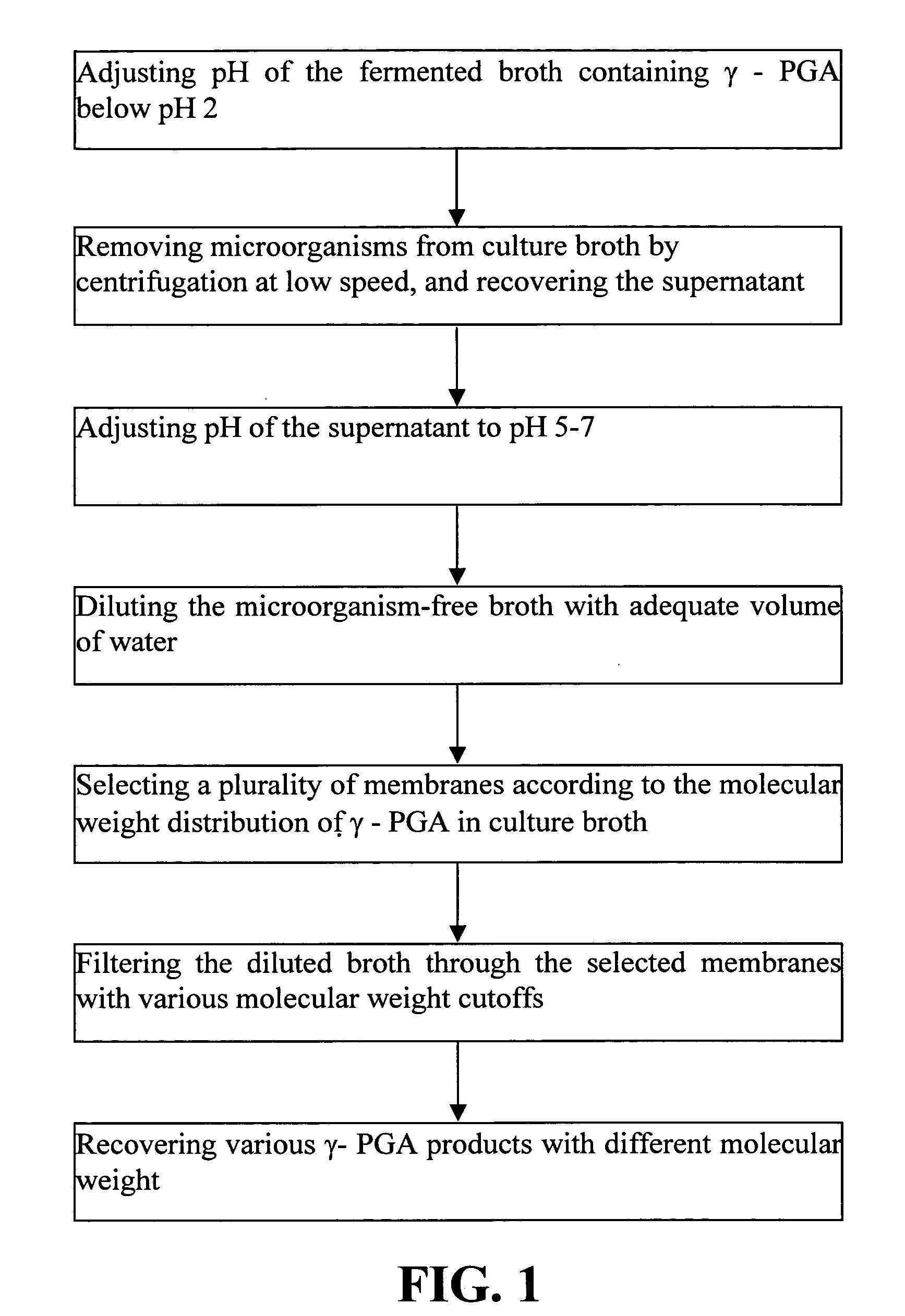Method for recovering and purifying polyglutamic acid
a polyglutamic acid and purification technology, applied in the field of recovering and purifying polyglutamic acid, can solve the problems of large consumption of power and electricity, difficult to recover and purify the product of -pga, and expensive instruments capable of operating at high speed, so as to reduce the consumption of filtration membranes and reduce the water volume for dilution, the effect of recovering and purifying -pga efficiently
- Summary
- Abstract
- Description
- Claims
- Application Information
AI Technical Summary
Benefits of technology
Problems solved by technology
Method used
Image
Examples
example 1
Fermentation of Bacillus licheniformis to Produce γ-PGA
A 7 L of medium containing 65 g / L sodium glutamate, 22 g / L citric acid, 170 g / L glycerin, 7 g / L NH4Cl, 0.5 g / L MgSO4.4˜6H2O, 0.15 g / L MnSO4.4˜6H2O, 0.15 g / L CaCl2.2 H2O, 0.04 g / L FeCl3.6H2O, 0.5 g / L K2HPO4.4˜6H2O is prepared for culture, and the pH value of the medium is adjusted to about pH 6.5.
The activated Bacillus licheniformis is inoculated into the medium, cultured in a 10 L of fermentor. Fermentation is performed at 37° C. for 96 hours under a condition of controlled pH 6.5, stirring speed of 200 rpm and aeration rate of 3 vvm. After fermentation, viscosity measurement of the broth indicates a viscosity of 238 cp. Additionally, the molecular weight distribution of γ-PGA in final fermented broth is determined by gel permeation chromatography (GPC) measurement, Mw is 3,688,149, Mn is 156,002 and Mw / Mn is 23.641. The result of GPC measurement is shown as FIG. 2, γ-PGA can be fractionated into two groups; one is high mol...
example 2
Recovery and Purification of γ-PGA
The final fermented broth obtained in accordance with Example 1 is adjusted to pH 2, stirred for 30 minutes, and centrifuged at 4° C. for 30 minutes to remove microorganisms. The supernatant after centrifugation is adjusted to about pH 7 with 6 N sodium hydroxide, and then diluted by adding four-fold volume of water. According to the molecular weight distribution of γ-PGA in broth, two molecular weight cutoffs of membranes are employed in the filtration process. The diluted broth is processed by the filtration system (Pellicon 2, Millipore), firstly through a membrane of 500 kD molecular weight cutoff and circulated twice to obtain the high molecular weight polymer (thousands of thousands), then the filtrate is passed through a membrane of 10 kD molecular weight cutoff and circulated twice to obtain the low molecular weight polymer (tens of thousands to hundreds of thousands).
The product of γ-PGA obtained from the present invention is characteri...
example 3
A culture is performed as described in Example 1 except the culture medium contains 50 g / L sodium glutamate, 16 g / L citric acid, 135 g / L glycerin, 7 g / L Urea, 0.5 g / L MgSO4.7 H2O, 0.15 g / L MnSO4.4-6 H2O, 0.15 g / L CaCl2.2 H2O, 0.04 g / L FeCl3.6H2O, 0.5 g / L K2HPO4.4-6 H2O. The resulting broth is performed described in Example 2 to recover and purify γ-PGA, 34.65 g of sodium poly glutamate is obtained from per litter fermented broth after the process of the present invention.
PUM
| Property | Measurement | Unit |
|---|---|---|
| pH | aaaaa | aaaaa |
| pH | aaaaa | aaaaa |
| pH | aaaaa | aaaaa |
Abstract
Description
Claims
Application Information
 Login to View More
Login to View More - R&D
- Intellectual Property
- Life Sciences
- Materials
- Tech Scout
- Unparalleled Data Quality
- Higher Quality Content
- 60% Fewer Hallucinations
Browse by: Latest US Patents, China's latest patents, Technical Efficacy Thesaurus, Application Domain, Technology Topic, Popular Technical Reports.
© 2025 PatSnap. All rights reserved.Legal|Privacy policy|Modern Slavery Act Transparency Statement|Sitemap|About US| Contact US: help@patsnap.com



